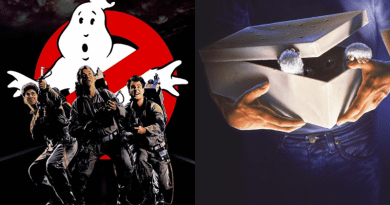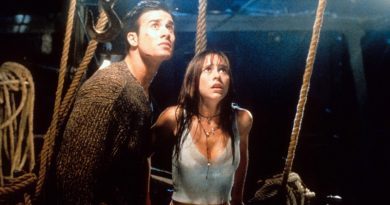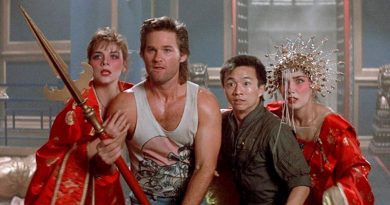Ranking Every Quentin Tarantino’s Movie, From Worst To Best
Whether you love him or loathe him, it’s hard to deny that Quentin Tarantino’s highly-influential film contribution to Hollywood and cinema in general. He may have been one of the most controversial, divisive and even sometimes misunderstood Hollywood filmmakers of our generation. But his body of work from the day he emerged onto the film scene with 1992’s Reservoir Dogs has been mostly consistent and inspired countless debates among many cinephiles from around the world. Tarantino’s signature blend of pop culture-heavy and witty dialogues are endlessly quotable, while his vast knowledge of world cinema and Hollywood movies of yesteryears can be evidently seen throughout his illustrious filmography.
Now, with Quentin Tarantino’s highly-anticipated comeback to the director’s chair in Once Upon a Time in… Hollywood since 2015’s The Hateful Eight set to arrive in our local cinemas this August 15th, it’s time to revisit all of the past feature-length movies he has directed so far, ranking from worst to best.
9) Death Proof (2007)

Originally conceived as one-half of the Grindhouse double feature alongside Robert Rodriguez’s Planet Terror, this extended standalone version was released with approximately 30 minutes’ worth of additional footage. The shorter 90-minute theatrical cut seen in Grindhouse‘s Death Proof was already a tedious slog and the additional footage featured in the extended version only drags the movie further. This is the rare time where I found Tarantino’s typically snappy dialogue in Death Proof felt like he’s trying too hard to sound cool. Even with all the characters endlessly rambling everything from Hollywood stunts to 1970s classic car films with the likes of Vanishing Point (1971) and Dirty Mary, Crazy Larry (1974), Tarantino just couldn’t make his dialogue work on the screen. The only few things that did work in Death Proof are Kurt Russell’s spot-on performance as the sleazy and psychotic Stuntman Mike alongside Zoë Bell’s (famously doubled for Uma Thurman in Kill Bill) bravura stunt work, in which she literally hangs on the hood of a speeding muscle car with just two belts tying on the front doors. The car stunts — including the head-on collision and the final 20-minute car chase — are particularly worth mentioning here, with Tarantino insists to shoot everything practical with no CGI.
8) The Hateful Eight (2015)

The Hateful Eight is equivalent of a neo-Western version of Tarantino’s own Reservoir Dogs (1992). Both movies shared the same DNA where a small group of characters gathered in the confines of a single location (in the case of The Hateful Eight, it would be a haberdashery instead of Reservoir Dogs‘ warehouse setting). But unlike Reservoir Dogs, The Hateful Eight is needlessly overlong as it clocks at nearly 3 hours long (!). This is particularly evident during the sluggish first half where several characters spend their time on a long stagecoach journey. Still, it has its few memorable moments including a solid ensemble cast led by Kurt Russell, Samuel L. Jackson and Jennifer Jason Leigh alongside the movie’s Agatha Christie-like whodunit in the second half and Ennio Morricone’s memorable score. And of course, the classic Tarantino moment where Samuel L. Jackson’s Major Marquis Warren delivers a shockingly graphic monologue on how he treats Bruce Dern’s General Sanford Smithers’ son (Craig Stark).
7) Kill Bill Vol. 2 (2004)

Sure, Quentin Tarantino himself has gone on record that Kill Bill was written as “one movie”. But personally, I still see it as two movies with significantly different tones even after all these years. Whereas Kill Bill Vol. 1 is more of an ultra-violent, blood-soaked homage to old-school Shaw Brothers kung fu flicks and samurai cinema, Kill Bill Vol. 2 sees Tarantino scaled back considerably in favour of a slow-burn, character-driven revenge drama. It was nevertheless a bold move, though a tad anticlimactic while some of Tarantino’s mellow and sentimental narrative approach felt patchy in places. Still, despite some of the flaws, there are numerous moments in Kill Bill Vol. 2 worth mentioning here. This includes a brutal fight scene between Uma Thurman’s Beatrix Kiddo and Daryl Hannah’s Elle Driver within the tight confines of Budd’s (Michael Madsen) caravan, which ends up in a graphically-violent moment that it’s still impossible for me not to look away. And who could forget the Shaw Brothers-style intense training sequence between Beatrix and Gordon Liu’s white-bearded master Pai Mei?
6) Jackie Brown (1997)

I still remembered when I first saw Jackie Brown on VCD back in the late 90s. Back then, Tarantino was riding high with his two cinematic masterpieces of Reservoir Dogs (1992) and Pulp Fiction (1994). Naturally, I was expecting Jackie Brown to be more in line with those two aforementioned movies. But what I got here instead was something radically different both tonally and even stylistically. To put it simply, Tarantino has suddenly gone mellow and less experimental in Jackie Brown — something which I have trouble accepting it in the first place. Which also explained why the movie died a quick death in the US box office when it was initially released back in December 1997. It only took me a couple of revisits that I started to appreciate this movie, even though his leisurely-paced 154-minute ode to blaxploitation films does tend to overstay its welcome. Likewise, Jackie Brown contains some of Tarantino’s best works including two memorable extended set-pieces involving Samuel L. Jackson’s Ordell Robbie and Chris Tucker’s Beaumont Livingston as well as the climactic “money exchange” scene in a shopping mall. The characters are all well-realised, with Samuel L. Jackson pulls off one of his best antagonist roles as Ordell Robbie while the former 1970s blaxploitation star Pam Grier and Robert Forster (who earned the movie’s sole Oscar nomination for Best Supporting Actor) both deliver career-best performances as the titular Jackie Brown and bondsman Max Cherry.
5) Django Unchained (2012)

Tarantino’s first foray into the Western genre is a fun, subversive and no-holds-barred take of the 1960s spaghetti western subgenre once populated by Sergio Leone’s The Man with No Name trilogy and Sergio Corbucci’s 1966 Django starring the legendary Franco Nero. He never shies away when comes to depicting the movie’s racial overtones on American slavery while offering a revisionist take on the protagonist typically reserved for a white actor by making Jamie Foxx’s titular Django character an unlikely saviour. While Foxx acquits himself well enough, it was Christoph Waltz’s fine supporting (and Oscar-winning) turn as the bounty hunter Dr King Schultz who excels the most. And as expected from a Tarantino’s film, the violence is as graphic and purposefully exaggerated as they come, complete with whistling bullets and tons of blood splattering from gunshot wounds like ketchup spills.
4) Kill Bill Vol. 1 (2003)

Words like “fun” and “unapologetically violent” are best described for Quentin Tarantino’s exhilarating first volume of his two-part revenge epic Kill Bill. He clearly has a field day paying homage to every martial arts cinema of the yesteryears from Shaw Brothers kung fu genre to Japanese samurai movies. The action is top-notch, thanks to legendary Hong Kong choreographer Yuen Woo-Ping as the movie’s martial arts advisor. This is particularly evident during the movie’s “House of Blue Leaves” sword-fighting centrepiece involving Uma Thurman’s nameless protagonist, all dressed up in an iconic Bruce Lee’s yellow-and-black jumpsuit while single-handedly taking down O-Ren Ishii’s (Lucy Liu) personal army of Crazy 88 and Chiaki Kuriyama’s schoolgirl bodyguard Gogo Yubari.
3) Inglourious Basterds (2009)

Tarantino gleefully deconstructs WWII movie — notably, the men-on-a-mission subgenre populated by the likes of The Dirty Dozen (1967) and Kelly’s Heroes (1970) — and made it his own in Inglourious Basterds. The result is a revisionist take of a “what-if” WWII scenario about how a group of American Nazi hunters led by Lieutenant Aldo Raine (Brad Pitt) devises an elaborate plan to kill Adolf Hitler (Martin Wuttke). The movie benefits from great performances all around, particularly a scene-stealing turn by Christoph Waltz as Colonel Hans Landa — a role that famously won him a much-deserved Best Supporting Oscar. Not to forget two of among Tarantino’s most memorable set-pieces ever staged in his career: a suspenseful opening sequence involving the interrogation between Christoph Waltz’s Colonel Hans Landa and Denis Ménochet’s suspected dairy farmer Perrier LaPadite and the all-hell-breaks-loose shootout massacre in a basement bar.
2) Reservoir Dogs (1992)

Both a Sundance darling and among the cultural milestone of American independent cinema, Quentin Tarantino’s acclaimed 1992 feature-length debut in Reservoir Dogs offers a refreshing change of pace on the oft-seen heist genre. What makes the movie such an iconic piece of cinema is Tarantino’s catchy pop-culture references and witty dialogues, which can be evidently seen in the opening diner scene debating everything from Madonna’s “Like a Virgin” to the rule of tipping a waitress in America. Although it was technically a heist film, Tarantino is bold enough not to show us anything from the actual robbery. Everything in the movie focuses more on the aftermath as well as its ugly consequences, complete with Ringo Lam’s City on Fire-inspired Mexican standoff finale — a result that made Reservoir Dogs all the more unique in the first place. Coupled with the movie’s fascinating non-linear storyline — a narrative device that Tarantino perfected it even better in Pulp Fiction — and a solid ensemble cast led by Harvey Keitel’s Mr White, Reservoir Dogs is undoubtedly one for the ages. The movie, of course, also best known for its memorable long-take scene involving Michael Madsen’s Mr Blonde casually slicing the ear off a cop (Kirk Baltz) while Stealers Wheel’s “Stuck in the Middle with You” played in the background.
1) Pulp Fiction (1994)

Pulp Fiction may have been 25 years old. But for all the movies that Tarantino has made throughout his illustrious career, his 1994 sophomore effort remains his finest work ever made. Which is actually ironic, especially when I first remembered how I used to despise the movie so much back in the VHS era. But the movie subsequently grew on me after a few revisits over the years since then. Tarantino has no doubt perfected the art of non-linear storyline first introduced in Reservoir Dogs, making the movie all the more interesting and compulsively watchable.
The thing about Pulp Fiction that I liked the most is how Tarantino manages to subvert our expectations, particularly upon the first viewing. For instance, a supposedly casual scene of a gangster (John Travolta’s Vincent Vega) taking out his boss’s (Ving Rhames’ Marsellus Wallace) raven-haired wife Mia (Uma Thurman) to dinner, only to end up in an unexpected circumstance. This also goes with other “anything-can-happen” scenarios including the shocking pawnshop scene (yes, it still does even after all these years) and the darkly hilarious “gun went off” moment. Pulp Fiction is more than just a film. It’s a once-in-a-lifetime cinematic journey altogether, complete with elements of surprises that are daring enough to take the road less travelled.




